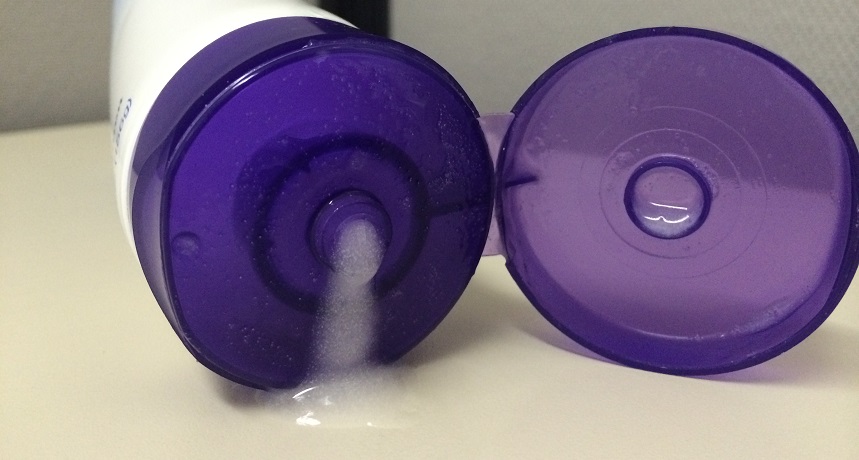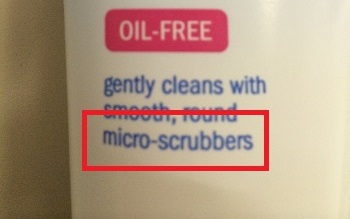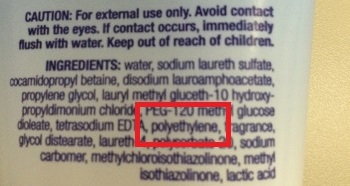Mailing off my microbeads
Here’s how to recycle some microplastics for science

That nice scrubby feeling in my face wash is due to little particles of plastic. If you look carefully you can see the tiny particles in the fluid. These microbeads slip through filters and can make their way to the ocean.
B. Brookshire/SSP
I’ve always been worried about plastic. Photos all over the Internet show seabirds with stomachs full of plastic bottle caps and sea turtles trapped in plastic bags. I don’t want to hurt animals living in the sea, so I try not to use too much plastic. I use metal water bottles that I can wash and reuse over and over. I bring cloth totes to the grocery so that I don’t need to take plastic ones home from the store. But I was very surprised to learn that another form of plastic — a type almost too small to see — can also pose an ocean problem. I was even more shocked to learn that I was using this plastic every day, and then washing it down the drain when I was done.
That plastic is in my face wash.
While it might seem odd to wash your face with plastic, many popular face cleansers include small plastic beads. Really small beads. The beads that give your face wash that gritty feeling are usually between 0.05 and 0.5 millimeters (one thousandth to one hundredth of an inch) in diameter. That span ranges from about the size of the tip of a needle to the tip of a ballpoint pen. These beads can be made of any of several common plastics. Among them are polyethylene, polypropylene and nylon.

Scientists have, in fact, been finding more and more microbeads in oceans and lakes. This could be a problem for many forms of ocean life. Fish and zooplankton — small ocean animals that float in the water, including tiny shrimp, jellyfish and fish larvae — sometimes eat these microbeads. “The small size makes them more likely to be ingested by sea beasties both big and small, because they might be mistaken for food,” explains Kim Martini. She’s a marine scientist at the University of Washington in Seattle.
The tiny balls of plastic also absorb other kinds of pollutants, such as pesticides. Chelsea Rochman works at the University of California, Davis, where she studies the effects of pollutants on the environment. She has shown altered hormone levels in small fish that had eaten plastic microbeads. Those hormone changes are a sign that the plastics — and the pollutants they may have absorbed — can affect fish health.

All of this helps explain why I don’t want to wash microbeads down the drain. Luckily, companies such as Johnson & Johnson and Unilever are getting rid of the plastic scrubbers in their face washes and other personal-care products. But the change will take a while. Their products could remain on store shelves until at least 2015. In the meantime, I will be looking for an alternative that doesn’t rely on plastic microbeads.
But what can I do with the face wash I already have? Throwing it away might still allow its plastic beads to end up in the ocean.
Luckily, I’ve learned that I can donate my face wash to science — and so can you! Sherri Mason is collecting products that contain microbeads. A chemist at the State University of New York in Fredonia, she (and the scientists in her lab) study plastics and their effects on waterways.
“We actually know little about the microbeads themselves,” Mason says. “We are collecting products from store shelves, rinsing away the cleanser to reveal the microbeads.” She and her lab will then study the beads to learn more about their sizes, shapes and how they might absorb other chemicals.
I’m going to help by packing up my face wash and mailing it to her at:
SUNY Fredonia
Attn: Sherri Mason
280 Central Ave.
340 Sciences Complex
Fredonia, NY 14063
Follow Eureka! Lab on Twitter
Power Words
chemistry The field of science that deals with the composition, structure and properties of substances and how they interact with one another. Chemists use this knowledge to study unfamiliar substances, to reproduce large quantities of useful substances or to design and create new and useful substances.
filter (in chemistry and environmental science) A device which allows some materials to pass through but not others, based on their size or some other feature.
hormone A chemical produced in a gland and then carried in the bloodstream to another part of the body. Hormones control many important body activities, such as growth. Hormones act by triggering or regulating chemical reactions in the body.
marine Having to do with the ocean world or environment.
marine biologist A scientist who studies creatures that live in ocean water, from bacteria and shellfish to kelp and whales.
microbead A small particle of plastic, usually between 0.05 millimeters and 5 millimeters in size (or one hundredth of an inch to about two tenths of an inch). These particles can be found in exfoliating face wash, but can also take the form of fibers shed from clothing.
plankton A small organism that drifts or floats in the sea. Depending on the species, plankton range from microscopic sizes to organisms about the size of a flea. Some are tiny animals. Others are plantlike organisms. Although individual plankton are very small, they form massive colonies, numbering in the billions. The largest animal in the world, the blue whale, lives on plankton.
plastic Any of a series of materials that are easily deformable; or synthetic materials that have been made from polymers (long strings of some building-block molecule) that tend to be lightweight, inexpensive and resistant to degradation.
pollutant A substance that taints something — such as the air, water, our bodies or products. Some pollutants are chemicals, such as pesticides. Others may be radiation, including excess heat or light. Even weeds and other invasive species can be considered a type of biological pollution.
zooplankton Small organisms that drift in the sea. Zooplankton are tiny animals that eat other plankton. They also serve as an important food source for other marine creatures.







